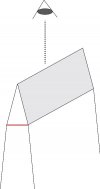- Joined
- Nov 19, 2014
- Messages
- 2,633
I am looking for a good method to measure the thickness behind the edge.
It is because I am planning to investigate the relationship between the blade geometry and sliceyness myself.
It is not hard to measure it with a micrometer, when the edge is thick.
But below 0.01", it becomes quite difficult to put the micrometer to the right place, partly due to my presbyopia.
So, I tried an alternative method.
I took pictures of the edge from above along with a ruler using my iPhone at the highest zoom.
(I first verified the accuracy of the ruler using a certified microscope reticule slide.)
The ruler was lifted to a similar height to the edge bevel.
The focus and exposure were adjusted to the ruler and fixed.
I used the burst mode to take 10 consecutive images.
Then, on the computer, I aligned the images and sum them to intensify the signal (using ImageJ freeware).
With right lighting and focusing, I could clearly see the transition points from the edge bevel to the primary grind.

Then, I determined the length of a millimeter (or a few) in the image and computed the "thickness" of the edge bevel.
The values I got were quite consistent with those I previously measured using a micrometer, at least for thick edge knives.
With this method, I can measure very thin edges at 0.003".
You just need a camera, a holder to keep the camera above a blade, a ruler, and a platform to lift it.
I think it works for now.
But I have seen microscopic measurements of edge thickness using some kind of molding.
That looked great and must be more accurate.
Anyway, if you know a better way to measure the thickness behind the edge, please let me know.
It is because I am planning to investigate the relationship between the blade geometry and sliceyness myself.
It is not hard to measure it with a micrometer, when the edge is thick.
But below 0.01", it becomes quite difficult to put the micrometer to the right place, partly due to my presbyopia.
So, I tried an alternative method.
I took pictures of the edge from above along with a ruler using my iPhone at the highest zoom.
(I first verified the accuracy of the ruler using a certified microscope reticule slide.)
The ruler was lifted to a similar height to the edge bevel.
The focus and exposure were adjusted to the ruler and fixed.
I used the burst mode to take 10 consecutive images.
Then, on the computer, I aligned the images and sum them to intensify the signal (using ImageJ freeware).
With right lighting and focusing, I could clearly see the transition points from the edge bevel to the primary grind.

Then, I determined the length of a millimeter (or a few) in the image and computed the "thickness" of the edge bevel.
The values I got were quite consistent with those I previously measured using a micrometer, at least for thick edge knives.
With this method, I can measure very thin edges at 0.003".
You just need a camera, a holder to keep the camera above a blade, a ruler, and a platform to lift it.
I think it works for now.
But I have seen microscopic measurements of edge thickness using some kind of molding.
That looked great and must be more accurate.
Anyway, if you know a better way to measure the thickness behind the edge, please let me know.

